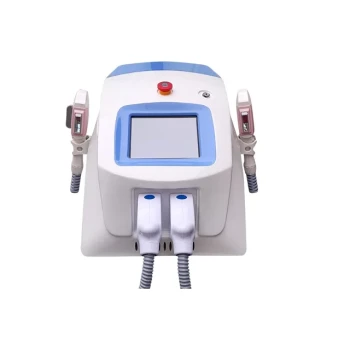The short answer is no. Intense Pulsed Light (IPL) does not work equally well or safely on all skin types. Its effectiveness and safety are fundamentally linked to the contrast between your skin tone and the pigment in the hair or dark spot you are targeting.
The core principle is simple: IPL technology targets melanin, the pigment that gives color to both skin and hair. For darker skin tones, the device can struggle to differentiate between the melanin in the hair and the melanin in the skin, creating a significant risk of burns and other side effects.

How IPL Technology Actually Works
To understand the limitations, you must first understand the mechanism. IPL is not a laser; it's a device that emits a broad spectrum of light in powerful pulses.
The Role of Melanin
Melanin acts as the target, or chromophore, for the light energy. When the light flashes, the melanin in the target (like a hair follicle) absorbs this light energy.
Light Absorption and Heat
This absorbed light converts into heat. The goal is to generate enough heat to damage the hair follicle and prevent future growth or to break apart the pigment that causes dark spots, without harming the surrounding skin.
Why Skin Type is the Critical Factor
The success of this process depends almost entirely on the amount of melanin in your skin versus the amount in the target. Professionals use a classification system called the Fitzpatrick scale to categorize skin types and predict their reaction to light-based treatments.
The Fitzpatrick Scale: A Standard for Skin Typing
This scale ranges from Type I (very pale skin that always burns) to Type VI (deeply pigmented dark brown to black skin that never burns). It is the industry standard for assessing risk with light-based therapies like IPL.
High Contrast = High Success
The ideal candidate for IPL has light skin (Fitzpatrick I-III) and dark hair. In this scenario, the light energy is strongly absorbed by the dark hair follicle while the surrounding light skin reflects it, minimizing the risk of a burn.
Low Contrast = High Risk
For individuals with darker skin (Fitzpatrick IV-VI), there is a low contrast between the skin and the hair. The IPL device cannot easily distinguish the target. The melanin in the skin absorbs a dangerous amount of light energy, which can lead to damage.
Understanding the Trade-offs and Risks for Darker Skin
Attempting IPL on unsuitable skin tones is not just ineffective; it can be dangerous. It is crucial to understand the potential consequences.
Potential Side Effects
The primary risk is that the energy intended for the hair follicle is absorbed by the skin. This can cause burns, blistering, scarring, and changes in skin color, including hyperpigmentation (darkening of the skin) or, more permanently, hypopigmentation (lightening of the skin).
Reduced Efficacy
To mitigate these risks on darker skin, a technician may be forced to use a much lower energy setting. This dramatically reduces the treatment's effectiveness, often leading to poor results and requiring more sessions, which further increases the cumulative risk.
The Promise of Modern Devices
Some newer professional and at-home IPL devices have been engineered with advanced filters or longer wavelengths to be "safer" for darker skin. Many at-home units now include skin tone sensors that will lock the device if the skin is too dark. While an improvement, these do not eliminate the fundamental risk.
Making the Right Choice for Your Skin Tone
Your safety must be the top priority. The correct choice depends entirely on an honest assessment of your skin type and your treatment goals.
- If you have fair to light-olive skin (Fitzpatrick I-III): IPL is generally a safe and effective option for hair removal and treating pigmentation issues.
- If you have medium to dark brown skin (Fitzpatrick IV-VI): You should be extremely cautious with IPL and seek alternatives. Lasers like the Nd:YAG are specifically designed for safer use on darker skin tones.
- If you are considering an at-home device: Strictly follow the manufacturer's skin tone chart and never attempt to use it if your skin is outside the approved range.
Ultimately, a consultation with a board-certified dermatologist is the only way to ensure you choose the safest and most effective treatment for your unique skin.
Summary Table:
| Skin Type (Fitzpatrick Scale) | IPL Suitability | Key Considerations |
|---|---|---|
| I-III (Fair to Light Olive) | Ideal | High contrast with dark hair; safe and effective. |
| IV-VI (Medium Brown to Dark) | High Risk / Not Recommended | Low contrast; risk of burns, blistering, and pigmentation changes. |
| All Types (Using At-Home Devices) | Check Manufacturer's Guide | Many devices have skin tone sensors; never use outside approved range. |
Unsure which technology is right for your clinic or salon? BELIS specializes in professional medical aesthetic equipment, including advanced systems designed for a wider range of skin types. Our experts can help you select the safest and most effective devices for your clientele. Contact our specialists today for a personalized consultation.
Visual Guide

Related Products
- IPL SHR Hair Removal Machine for Permanent Hair Removal
- Clinic Use IPL and SHR Hair Removal Machine with Nd Yag Laser Tattoo Removal
- Clinic Use IPL SHR ND YAG Laser Hair Removal RF Skin Tightening Machine
- IPL SHR+Radio frecuency machine
- Diode Tri Laser Hair Removal Machine for Clinic Use
People Also Ask
- Who should not use IPL? Key Contraindications for Safe Skin Treatment
- Does IPL hair removal really work? Unlock Long-Term Hair Reduction with Science
- Can you use hair removal device on private parts? A Guide to Safe Bikini Area IPL
- Does IPL hair removal actually work? Achieve Long-Term Hair Reduction
- What are the negative effects of IPL? Understanding Risks for Safe Treatment



















